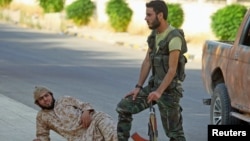An al-Qaida affiliate abducted an American-trained rebel commander and seven of his fighters in northern Syria just days after they deployed in the war-torn country.
The mid-week kidnapping is seen by analysts as a setback to Washington’s effort to shape an insurgent force able to combat Islamic State extremists, and it is likely to complicate plans for a safe zone in northern Syria currently under discussion between U.S. and Turkish officials.
According to a monitoring group, fighters with the rebel militia Division 30 were snatched on Tuesday night by jihadists mounting a checkpoint near the Syrian town of Zahart al-Malkia, about 40 kilometers northeast of Homs.
The Britain-based Syrian Observatory for Human Rights said the incident happened as the fighters were “returning from a meeting in the city of Azaz in northern Aleppo province to their headquarters.”
The observatory said the fighters had met with other rebel factions about a coordinated assault on the Islamic State, also known as ISIS or ISIL.
“Forces from al-Nusra Front kidnapped the commander of Division 30, Colonel Nadim Hassan, along with seven members of the division, including commander Farhan al-Jassem,” according to a statement by the monitoring group, which relies on political activists on the ground for its information.
Turkey's state-run news service, Anadolu Agency, put the number of abductees higher, reporting that 18 fighters were kidnapped. The agency said most of the group consisted of Turkmen, quoting the head of the Syrian Turkmen National Movement.
The Division 30 rebel militia put out a statement Thursday accusing al-Nusra of the abduction of Hassan and his men, urging the jihadist group to free them. Most of the 60 or so fighters, who have so far completed Washington’s train-and-equip program, are from Division 30.
Questions abound
Washington and Ankara announced this week they would provide air cover for a select group of Syrian rebels in their plan to sweep Islamic State fighters from an earmarked zone along the border with Turkey inside northern Syria.
It has remained unclear, however, which established rebel groups Washington and Ankara would back. U.S. officials, speaking on the condition of anonymity, acknowledge that some Islamist militias aligned with Jabhat al-Nusra and favored by Turkish officials, are not to the liking of Washington.
Even before this week’s abduction, U.S. officials admitted that one of the big challenges with the planned safe zone, stretching 40 kilometers inside Syria, is that al-Nusra and a hardline Islamist militia, Ahrar al-Sham, are strong in the area. Also, other rebel factions have had to rely on them to keep the important border city of Azaz from falling into Islamic State hands.
The train-and-equip program was first announced last year, after Islamic State extremists seized the Iraqi city of Mosul and announced a caliphate straddling Syria and Iraq.
The U.S. Congress allocated $500 million with the aim of training within three years as many as 15,000 ideologically moderate fighters able to combat Islamic State — a group that has seized wide areas of Syria — and to act as reliable local partners for the U.S. on the ground in northern Syria.
The al-Nusra Front, a rival to the Islamic State group, has targeted U.S.-backed rebels in Syria. Last year, it routed two rebel militias, the Syria Revolutionaries Front and the Hazzm Movement. Division 30 called on al-Nusra Front to free the abductees “as quickly as possible to preserve Muslim blood and avoid weakening the fronts with side disputes between brothers.”
Slow pace chided
The train-and-equip program has been plagued by problems since its launch, with U.S. lawmakers complaining about its slow pace. In testimony before a Senate panel this month, U.S. Secretary of Defense Ash Carter acknowledged that only 60 fighters had completed training.
That prompted Senator John McCain to dub the admission “troubling,” warning that, “The goal of degrading and ultimately destroying ISIL will never be accomplished while the conflict in Syria continues. Bashar Assad’s war on the Syrian people has fostered the conditions for ISIL’s continued growth, recruitment, and radicalization of Muslims across the world.”
Syrian rebel commanders, who have been loath to volunteer their men for the program, say the two biggest problems with the mission rest with how tightly Washington defines “moderate” and on the Obama administration’s insistence that the train-and-equip force can only be used against Islamic State extremists and not against the Syrian president.
Few veteran rebel fighters want to join a force that is focused only on ISIL. They say Assad is responsible for many more deaths in Syria than the jihadists.
“I told them from the start I wouldn’t offer one man as long as the force was only going after ISIL,” a rebel commander told VOA. He said he could see no purpose in weakening his forces, who are mainly fighting Assad’s army, to take on the Islamic State group.
U.S. officials, though, say the challenges in shaping a reliable force dictate the slow pace of the program.
Secretary Carter told a House committee in early July the project involving Syrian rebels is "much trickier" than a similar effort under way with the Iraqis — in part because of concerns about controlling equipment issued to Syrian trainees and ensuring it doesn’t fall into jihadist hands.
Pentagon officials say 1,500 volunteers are waiting for the completion of a vetting process to join train-and-equip.
Recruitment efforts increasingly have focused on tribes from eastern Syria, say U.S. officials. President Barack Obama recently voiced frustration with the program, saying, “I have made it clear to my team that we will do more to train and equip the moderate opposition in Syria.”









